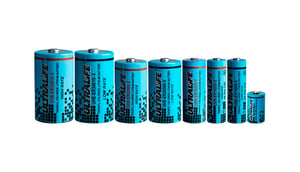The first smart meter was developed and produced in the late 70s and, by the mid-80s, manufacturers of these devices found Lithium Thionyl Chloride (Li/SOCl2) cells to be an extremely well-suited source of power due to their long service life that reduces the need for replacement. Ultralife has recently introduced a new line of Li/SOCl2 cells, called ER Generation X, that are a great option for those who consider performance, price and lead time.
What are the best batteries for smart meters?
Like many modern applications, smart meters may utilize batteries as their only source of power or as a backup in case of AC power failure. This puts a heavy reliance of battery performance, reliability and service life. When choosing a battery to integrate, many considerations must be made to ensure the device can operate effectively.
 For example, when smart meters relay energy usage data to the utility company (usually via. radio), the power needed to successfully convey this information depends on the transmission path, which can vary drastically and require a high current pulse.
For example, when smart meters relay energy usage data to the utility company (usually via. radio), the power needed to successfully convey this information depends on the transmission path, which can vary drastically and require a high current pulse.
Ultralife’s Generation X ER cells offer superior current capabilities, as well as a high and stable operating voltage.
There are also two types of Lithium Thionyl Chloride battery to choose from, spiral or bobbin construction, both of which offer distinct advantages.
Advantages of spiral cells:
Spiral-wound Lithium Thionyl Chloride batteries offer excellent pulse capability, with Ultralife’s Generation X D size spiral battery providing up to 4,000mA, 0.1 second pulses (drained every 2 min at + 20°C).
To extend battery life; smart meter manufacturers may take additional steps to reduce the frequency of the device requiring high current pulses, using a device sleep/standby mode and measurement/interrogation mode that records data before it is sent to the utility company in transmission mode.
Advantages of bobbin cells:
For OEMs who require increased capacity and lower constant discharge current more than pulse capability; bobbin cells are the best option. The cell capacity of the D size bobbin cell at 2mA is 16,000mAh to 2.0V @ +23°C. They also offer high energy density of more than 400 Whr/Kg.
Ultralife's ER Generation X cells (specifications*):
| Cell Type | Pulse Capability | Nominal Capacity to 2.0V @ +23°C | Weight |
|
Up to 100mA |
1,200mAh at 0.5mA |
10g | |
|
Up to 200mA, |
2,400mAh at 1mA |
18g | |
|
Up to 800mA, |
2,000mAh at 1mA |
19g | |
|
Up to 800mA, 1.0 second pulse |
3,000mAh at 1mA |
35g | |
|
Up to 200mA, |
7,500mAh at 2mA |
56g | |
|
Typically up to |
6,500mAh at 2mA |
58g | |
|
Up to 400mA, |
16,000mAh at 2mA |
104g | |
|
Typically up to |
14,500mAh at 10mA |
108g |
* For the latest specifications, please refer to the technical datasheets on the Ultralife website.
Real world testing verifies that the performance of Ultralife’s ER Generation X cells, across temperatures and rates, is on-par with the competition.










